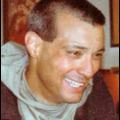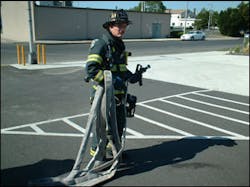Stretching Dry: Increasing Engine Company Effectiveness
Stretching a hoseline dry to the drop point is a real time saver and reduces stress dramatically.
A good engine company knows how to get a line into operation very quickly while at the same time providing for the safety of firefighters.
While the length of the hose stretch may vary from a short distance to several hundred feet, certain basic principles apply.
- The right diameter line must be chosen
- The correct amount of hose must be stretched
- Stretching a hoseline without water is many times easier than stretching a hoseline that is charged
The Right Weapon For The Job: 1 3/4 vs. 2 1/2
No matter what the situation is, the engine company must deliver the needed amount of water for the task at hand. Smaller fires may be well suited to the use of 1 3/4-inch hose while larger fires or fires in standpipe-equipped buildings are more suited to the use of 2 1/2-inch hose.
The 1 3/4-inch hoseline has the following characteristics:
- Good maneuverability - This can be viewed as an advantage for the limited staffed company. Unfortunately, this mindset may set the engine company up for failure as many times this line is stretched for situations that demand a larger line.
- Moderate flows of close to 200 gpm in stretches of up to 300 feet - Larger rates of heat release demand more water that cannot be delivered from a 1 3/4-inch line. In addition, a longer stretch will require more friction loss to be compensated for.
The 2 1/2-inch hoseline has the following characteristics:
- Fair maneuverability - The 2 1/2-inch handline is a fantastic tool when used aggressively. It is more than a line for defensive operations and can offer a lot of firepower when advanced offensively. The key here is to team up multiple engine companies to get a single line in operation. By teaming up engine companies, a 2 1/2-inch line can be moved very quickly, but the key is placing firefighters at each friction point or "pinch" point.
- Excellent water flow - Equipped with a 1 1/4-inch smoothbore nozzle will allow the engine company to flow 325 gpm. High flows can also be achieved with the newer low-pressure fog nozzles. Friction loss is also much less than using the smaller 1 3/4-inch line with the lesser flows.
Pre-Connected Lines vs. Bulk Hose Beds
The pre-connected line is not suitable for all stretches and an engine company should be equipped so as to get a line into operation at building fires where the "preconnect mindset" would cause ineffective hose stretches. A solution is 2 bulk hose beds with:
- 600 to 800 feet of 2 1/2-inch attack line with a high flow nozzle (1 1/4-inch smoothbore/325 gpm or a high flow/low pressure fog nozzle.
- 200 feet of 1 3/4-inch hose to a reducer to several hundred feet of 2 1/2-inch hose. This allows for 1 3/4-inch hose to be placed into operation many hundreds of feet from the engine, but without excessive friction loss. (see Figure 1)
Stretching the proper amount of hose is critical. Here are the basic rules of thumb from two exceptional chief officers. Obviously, there are always variables that can alter the amount of hose needed, but these are a good place to start.
- From William Clark's book Firefighting Principles and Practices, 2nd edition (Page 266, Penn Well Publishing, 1991), the author estimates one 50-foot length for each floor up to and including the fire floor, plus an additional length, plus the distance from the engine to the building entrance.
- For commercial occupancies, from John Norman's book Fire Officer's Handbook of Tactics, 3rd edition (Page 51, Penn Well Corporation, 2005), the author calculates the length of the building's frontage plus the depth of the building to estimate the amount of hose needed, plus an additional length for every additional floor the company must stretch to, plus the distance from the engine to the building entrance.
Stretching Dry
With minimal staffing how can we get a line into operation quickly? Obviously, it is much easier to stretch a hoseline that is uncharged. This, we can maneuver very quickly, even if with limited personnel.
But at what point do we call for water? What would be some good rules of thumb? These points offer a start:
- Use compartmentation to enhance your safety
- Use elevation differences for greater protection
- Use the exterior for your safety
Compartmentation is simply using fire resistive features to your advantage. For example, many building components offer some degree of fire resistivity. A fire rated door mounted within a fire rated wall and ceiling assembly offers protection to firefighters. With this protection intact, an engine company can stretch to this point with the line dry.
Differences in elevation take advantage of stretching a hoseline dry to the floor below the fire. This area of refuge offers a clear and smoke free atmosphere without the dangers of rollover or flashover.
The building dimensions, construction, fire location and extent may preclude stretching a line dry into the interior. This would call for the hoseline to be stretched dry to an exterior entrance of the building and water called for prior to entering.
The emphasis brought out by each of these three points is that a dry line must never be taken into areas that are immediately dangerous to life and health (IDLH). Areas prone to extreme forms of fire behavior such as flashover and rollover preclude any dry hoseline stretch. Remember, smoke contains combustible gases that when mixed with air and heat will ignite. Rapid fire spread is a very real consideration. A charged line offers significant protection.
When stretching a dry line, the nozzle firefighter should always be in the habit of taking not only the nozzle but also a fifty-foot length of hose to what is best identified as the drop point (see Figure 2). The drop point is that point within a building where compartmentation, elevation, or the building's exterior offer protection to the firefighters. It is also an area where fifty feet of hoseline can be flaked out so as to eliminate any kinks in the line.
Summary
Stretching a hoseline is critical to fireground success. Stretching a hoseline dry to the drop point is a real time saver and reduces stress dramatically. The key is to know when to call for water.
To gain real proficiency, try most of your stretches with 2 1/2-inch hose. By doing this, members will find the stretch of 1 3/4-inch hose extremely easy and more importantly won't forget the 2 1/2-inch line when it is needed most.
About the Author

Armand Guzzi
Firehouse.com Contributor
Armand F. Guzzi, Jr. has been a member of the fire service since 1987. He recently retired a career fire lieutenant with the City of Long Branch, NJ, Fire Department and is the deputy director of the Monmouth County, NJ, Fire Academy where he has taught for over 20 years. He has a Master's degree in management and undergraduate degrees in fire science, education, and business administration. View all of Armand's articles here. He can be reached via e-mail at [email protected] or [email protected].
